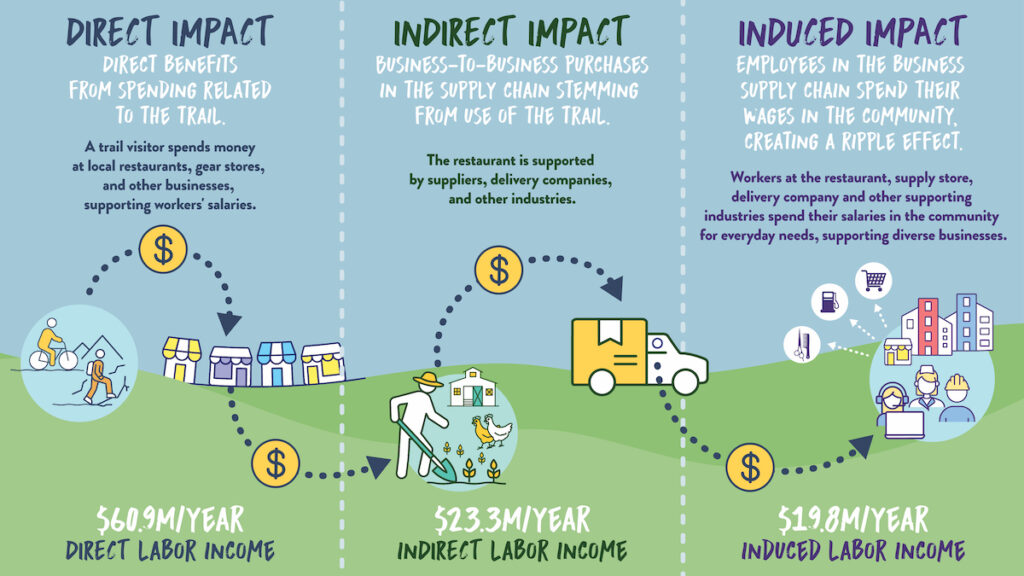Economic Impact
Wyoming’s Casper Rail Trail | Photo Courtesy of Platte River Rail Trail Trust
Economic Potential of the Great American Rail-Trail

As the Great American Rail-Trail® is completed, it has the potential to amplify the benefits—on a mass scale—that trails provide. In addition to offering places for physical activity and recreation, connecting diverse communities with safe walking and biking routes, and promoting a closer connection to nature, the Great American will serve as a catalyst for economic growth, helping communities along the route realize new economic potential.
However, to fully realize the economic opportunity that the trail promises, communities will need to plan for and invest in the trail. Such investments could generate more than $229.4 million in visitor spending, $104 million in labor income, and $22.8 million in new tax revenue.
“There are no cheap silver bullets in economic development, but a long-distance trail comes close; it brings in tourist dollars while also creating local activity in the towns it runs through, helping sell shoes, bikes and pumping up streetscape vitality.”
—Jon Snyder, Senior Outdoor Recreation and Economic Development Policy Advisor to Washington Gov. Jay Inslee

“As our region’s economy changes, it will become even more important to have multiuse trails connecting our towns, drawing visitors, and creating opportunities for recreation. As an employer, more trails will help me attract customers and talent.”
—Brooke Lincoln, Owner, the 50,000 Silver Dollar, Montana
Diverse Industries are Supported
Over ten years, the Great American Rail-Trail® will create more than 25,000 jobs across diverse sectors ranging from restaurants and retail to manufacturing, professional services, and health care. Investments in the Great American Rail-Trail can help revitalize communities, attract businesses and entrepreneurs, and keep residents, especially in rural places. In communities where the trail is not yet complete, it can help create new business opportunities and diverse jobs.
The Great American Rail-Trail is expected to generate more than $104 million in labor income each year. These wages are supported by trail visitors when they spend money at local businesses, directly supporting workers. In turn, those businesses purchase supplies from other businesses, creating indirect impacts. When employees at those businesses spend their wages on everyday needs, a ripple effect is created throughout the community.

How We Measure Economic Impact
Headwaters Economics partnered with Rails-to-Trails Conservancy to conduct an independent economic impact analysis of the Great American Rail-Trail®. Economic impact analyses are based on the idea that something—whether a new trail, new business, or a new policy—can attract new money by enticing visitors who otherwise would not have come to the area. This new money, in turn, supports local businesses that employ residents, pay taxes, and support other businesses. These analyses require measuring the number of visitors drawn to the area and how much they spend.
The analysis was conducted in 2021-2022 using four data elements: 1) existing trail count data; 2) original statistical models to estimate trail users; 3) a literature review of spending and trail use characteristics; and 4) economic impact estimates from the IMPLAN economic modeling program. The economic benefits presented in this report rely on three underlying assumptions. First, we assume that communities will capitalize on the trail with businesses like gear shops, restaurants, and lodging; signage directing users to these local businesses; and marketing the community as a welcoming stop for trail users. Second, we assume that the increase in outdoor recreation observed during the pandemic will persist. This assumption is supported by data from Rails-to-Trails Conservancy’s national network of trail counters and the Outdoor Industry Association’s national survey on participation in outdoor recreation. Finally, we assume that the route in this assessment will be built and maintained at a level of quality that is connected to other segments; has a safe separation from vehicles; and has a surface that is sufficiently maintained to allow most skills and abilities to walk, bike, and roll. This analysis does not assume that all segments would be paved.